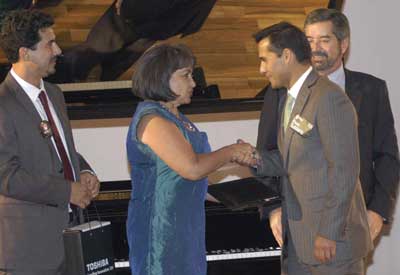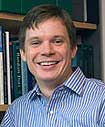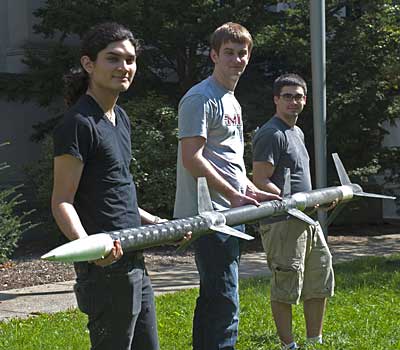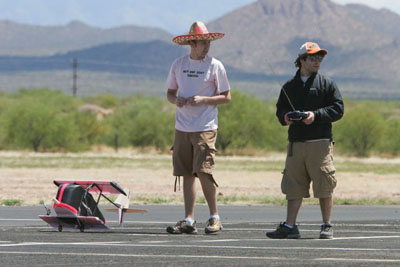| |
October 2011
|
|

1. Newsbriefs
• Ph.D. Candidate Brent Tweddle has captured two AIAA awards: the Foundation Guidance, Navigation, and Control Graduate Award; and the GNC Graduate Student Paper Competition, the latter for his paper "Relative Computer Vision Based Navigation for Small Inspection Spacecraft."
• AIAA will present Professor Hamsa Balakrishnan with its Lawrence Sperry Award "for the development and implementation of advanced air traffic management techniques leading to significant environmental improvements.” The award recognizes notable contributions by a young person (age 35 or under), to the advancement of aeronautics or astronautics.
• Professor Larry Young is a recipient of NASA's Johnson Space Center Achievement Award for his contributions to the book, "Wings in Orbit: Scientific and Engineering Legacies of the Space Shuttle 1971 - 2010."
• Professor Nancy Leveson has been appointed to the National Petroleum Council, an advisory board to the Secretary of Energy Steven Chu.
• At a ceremony in Mexico, Professor Paulo Lozano was presented the Quo+Discovery Channel Mente Futuro (Mind of the Future) Award for his work in miniaturizing propulsion that could reduce space access costs. The award committee included a Nobel laureate, heads of national universities, scientists, and renowned journalists.

At the Palacio de Bellas Artes in Mexico City, Paulo Lozano is congratulated on his Mente Futuro award.
• Professor Ed Crawley has received an honorary doctorate and professorship from the Moscow Aviation Institute.
• The 2012 Brigadier General Charles E. Yeager International Aeronautical Achievement Award will go to Professor of the Practice Bob Liebeck, honoring his "leadership in advancing lifting body design, contributions to the art and science of airfoil design, and advancement of aeronautics through engineering higher education." The award is presented by the Engineers' Council.
• At the International Conference on Engineering Design 2011 an MIT paper coauthored by Michael Pasqual and Professor Olivier de Weck won a Reviewers’ Favorite award. The paper, "Multilayer Network Model for Analysis and Management of Change Propagation," is based on Michael’s 2010 joint AeroAstro and Technology and Policy Program master’s thesis.
• Professor Moe Win, along with LIDS postdoc Santiago Mazuelas, and EECS grad student Yuan Shen, received the Best Paper Award at the IEEE International Conference on Ultra-Wideband 2011 for their paper "Wideband Cooperative Localization via Belief Condensation."
• Professor Jon How and grad student Brandon Luders' work applying " ... LabVIEW and CompactRIO to Design and Implement a Dynamic Output Feedback Controller" in the 16.30/31 class has won National Instruments' Application of the Year in Education Award.
• Rocket propulsion pioneer Yvonne C. Brill, who delivered the department's 2009 Gardener Lecture and was an honored guest at our first Women in Aerospace Symposium that same year, has been presented with the National Medal of Technology and Innovation by President Obama. The award cites her " innovation in rocket propulsion systems for geosynchronous and low earth orbit communication satellites, which greatly improved the effectiveness of space propulsion systems."
• Post-doc Roberto Guzmán de Villoria and grad student Sunny Wicks won two of the three Best Poster awards at MIT's Materials Day for their respective posters "Continuous Growth of Vertically Aligned Carbon Nanotubes" and "Hierarchical Structural Materials with Aligned Carbon Nanotubes for Multi-functional Applications." Roberto and Sunny are students of Professor Brian Wardle. Hosted by the the Department of Materials Science and Engineering's Materials Processing Center, this highly competitive symposium features cutting edge research from across MIT.
• The AeroAstro-Draper TALARIS planetary hopper was featured in the September issue of Air & Space magazine. |

Jim Hileman
|

2. Hileman named FAA environmental science chief
The FAA has appointed Partnership for AiR Transportation Noise and Emissions Reduction Associate Director Dr. Jim Hileman as its new Chief Scientific and Technical Advisor for Environment and Energy. MIT Dean of Engineering and PARTNER Director Ian Waitz said, "Jim has been a wonderful colleague, and his contributions, mentoring, and leadership within the MIT PARTNER team will be sorely missed. However, I also very much look forward to working with him in this new role. He is an excellent choice for this important position." Jim is a recent recipient of the of the FAA's Excellence in Aviation Research Award, which cited him for his ""seminal work on life cycle analysis of alternative jet fuels (that) led to the discovery that sustainable alternative jet fuels are crucial to reducing aircraft carbon dioxide emissions." Jim will begin his new job on November 7.
Dean Waitz has announced that AeroAstro Professor Steven Barrett will assume the position of PARTNER associate director upon Jim's departure. |
|

3. Welcome
Welcome to two new staffers:
- Meghan Pepin, who had been temping in the department, is now MIT staff, an administrative assistant supporting professors Darmofal, Drela, and Wang, and principal research engineer Bob Haimes.
- Kathleen Kelley has joined AeroAstro as a fiscal officer.
Not exactly a faculty or staff arrival, but two new AeroAstro arrivals: Professor Zolti Spakovszky welcomed baby Simon Carl on September 23. Four days later, there was an addition to Professor David Mindell's house: Clara June Mindell. Zolti and David report babies and moms doing well. |
|

4. The defenders
Since our last enews, the following students have successfully defended theses:
- Jeremy Agte, "Multistate Analysis and Design: Case Studies in Aerospace Design and Long Endurance Systems."
- Stephen Steiner III, "Carbon Nanotube Growth on Challenging Substrates: Applications for Carbon-Fiber Composites."
- Nikolaos Pyrgiotis, "A Stochastic and Dynamic Model of Delay Propagation Within an Airport Network For Policy Analysis."
- James Modisette, "An Automated Reliable Method for Two-Dimensional Reynolds-averaged Navier-Stokes Simulations."
Congratulations to all! |
|

5. Rocket team shoots for new heights
In an attempt to capture a $10,000 prize for reaching 100,000' with a model rocket, AeroAstro’s Rocket Team members traveled to Black Rock Desert, Nevada early this month with TYR (aka Odin’s Spear), a rocket they’d fabricated. Team member and safety officer Andrew Wimmer reports:
The MIT 3 stage rocket flew at around 10:40 a.m. on Oct. 1. Stage separation appeared to occur on time. Second stage ignition occurred after coasting for approximately 13 seconds, instead of the intended 10. The third stage ignited after a 17 seconds coast, instead of the intended 10 seconds. By this time, the third stage was nearly horizontal and the rocket was headed downrange fast. The first stage was recovered four miles downrange and achieved an altitude of 13,200 feet. The parachute on the first stage mostly stripped; impact was at 194fps. The second stage parachute lines were severed on deployment, and the parachute with attached tracker was recovered six miles downrange. The second stage was never to be seen again. The third stage is estimated to be 20-35 miles downrange; a signal could not be acquired before the tracker batteries died. It is unknown if the section attempted to deploy the streamer or main parachute, or what would happen if it did at the velocities it was flying at (more than Mach 3 at the peak). Even if we had been close enough to get a signal, it was unlikely that the rocket was still above ground or that the transmitters were intact enough to locate it.

Rocket Team members (from left) Julian Lemus, Andrew Wimmer, and Christian Valledor with TYR/Odin's Spear, the rocket they hoped would climb to 100,000 feet or more.
We believe the excess staging delay was caused by a number of factors. The igniters had been tested in an identical motor, however, this time likely increased with altitude and velocity. It is also possible that the altimeters did not fire them on time due to off vertical trajectory of the lower stages of the flight compounding with our allowance given for motors not lighting on time. Despite the flight not working as intended, the rocket held together during an extreme flight and the group learned a lot from the experience. |
|

6. DBF, RC Club seek members
AA student Jed Storey tells us that: "Design/Build/Fly is a yearly international radio-controlled aircraft competition sponsored by the AIAA, Raytheon, and Cessna. Each year, we design, build, and fly a high-performance aircraft to a set of challenging mission requirements. This year we have to engineer a plane that can fly as many laps as possible in four minutes, carry a payload of eight simulated passengers, and haul two litres of water to 100m as fast as possible, all while minimizing weight, and flying on a very limited amount of power. We are seeking any and all (freshmen to graduates) MIT students interested in designing, building, and flying a high performance aircraft, the aspects of which include: advanced composite structures, electric propulsion systems, and aerodynamic analysis." For more info, email the team at dbf12-exec@mit.edu.

The '07 AeroAstro team bested others from throughout the United States to take first place in the Design/Build/Fly competition. (Kevin Koller, Raytheon Missile Systems /AIAA photo)
The MIT RC Flight Club has been rejuvenated and is looking for new members. The club's goals are to teach the fundamentals of flight, organize weekly fly-outs on Briggs Field, and educate members about the hobby (building planes and helos, different RC applications, etc.) For more information, email Theodore Tzanetos at tzanetos@mit.edu |
 
|

Follow AeroAstro
Don't wait for your enews and emails — keep up with AeroAstro news as it happens — follow the department on Twitter and Facebook. |
|
If you know of events, honors, activities, or other information you'd like to see in the next issue of AeroAstro enews, please send to wlitant@mit.edu — we'd be pleased to include your submissions. |
|
|




